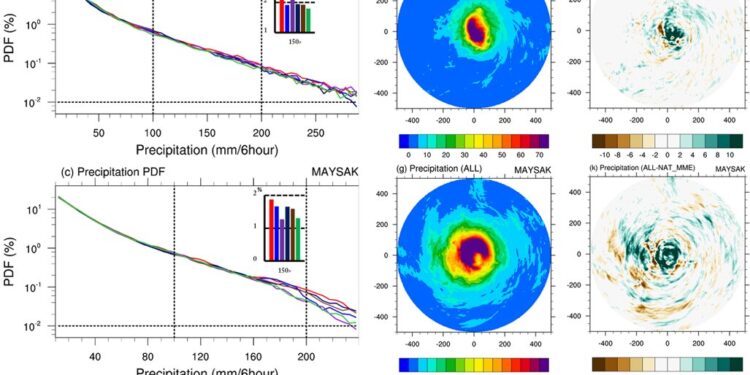Climate model simulation results for four powerful typhoons (Sanba, Chaba, Maysak, and Haishen) that recently hit the Korean Peninsula under two conditions: current climate conditions including all anthropogenic and natural factors (ALL) and counterfactual conditions devoid of anthropogenic warming effects (NAT). Credit: POSTECH
Last year, Typhoon Hinnamnor, which caused 36 deaths, became known as the first super typhoon to develop at a high latitude (25°N) since records by the Korea Meteorological Administration began. This year, in Osong, Chungcheongbuk-do region, an unexpected heavy downpour caused rivers to suddenly overflow, causing many casualties.
Rising temperatures on Earth are triggering unprecedented typhoons, torrential rains and other extreme weather events. Without reliable forecasts of climate extremes caused by global warming, mitigating the resulting damage remains a challenge.
Professor Seung-Ki Min and Dr Minkyu Lee, from the Division of Environmental Science and Engineering, Pohang University of Science and Technology (POSTECH), used a high-resolution climate model to conduct a pioneering quantitative analysis of the impact of global warming. on typhoons affecting the Korean peninsula. This research was recently published in npj Climate and atmospheric science.
In particular, global warming is giving way to an increase in more powerful typhoons which maintain their intensity longer and therefore cause greater damage. Accurate typhoon forecasting and damage reduction requires a better understanding of the influences of global warming, for which climate model simulations with km-scale resolution are essential. However, studies quantifying the contribution of anthropogenic warming to typhoons affecting Korea, particularly research on extreme precipitation accompanying typhoons, remain rare.
Differences between ALL6 and NAT6 in sea surface temperature (SST) in an MME, b Cluster 1, c Cluster 2, d Cluster 3 and e Cluster 4. f Scatterplot of the first and second principal components of the EOF (PC1 and PC2, respectively) of delta SST models (ALL-NAT) from 9 CMIP6 models and corresponding ensemble clusters. Credit: npj Climate and atmospheric science (2023). DOI: 10.1038/s41612-023-00509-w
To overcome this problem, the research team designed a 3 km high-resolution regional simulation climate model to study the impact of global warming on typhoon intensity and extreme precipitation. Four extremely severe typhoons that made landfall on the Korean Peninsula between 2011 and 2020 were chosen for simulation under current climate conditions and under counterfactual conditions without human-caused warming. To reduce uncertainties related to regional changes in sea surface temperature due to global warming, researchers used various models of ocean warming estimated from several CMIP6 climate models.
The results show that taking into account global warming due to human activities increased the overall intensity of typhoons and precipitation. The research team observed that the warming impact was more pronounced at the maximum typhoon intensity than at the average intensity. This implies more frequent occurrences of powerful super typhoons over East Asia in the future.
Additionally, the area exposed to extreme precipitation generated by typhoons increased by 16 to 37 percent due to warmer climatic conditions. Furthermore, the expansion of the extreme precipitation zone is attributed to the strengthening of the upward motion near the typhoon center and the increase in atmospheric water vapor due to warming of the ocean surface.
Professor Min explained: “Our results from high-resolution climate model simulations provide conclusive evidence that global warming has amplified the strength of recent typhoons that made landfall on the Korean Peninsula. Continued escalation of global warming could lead to stronger typhoons and heavier rainfall. extremes, requiring increased sector-specific preparedness measures.
More information:
Minkyu Lee et al, Convection-allowing simulations reveal widespread extreme precipitation from tropical cyclones affecting South Korea due to anthropogenic warming, npj Climate and atmospheric science (2023). DOI: 10.1038/s41612-023-00509-w
Provided by Pohang University of Science and Technology
Quote: Global warming intensifies extreme precipitation induced by typhoons over East Asia (December 29, 2023) extracted on December 30, 2023 from
This document is subject to copyright. Apart from fair use for private study or research purposes, no part may be reproduced without written permission. The content is provided for information only.



